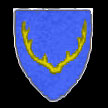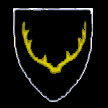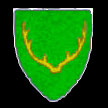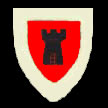


| General Info |
| Orders of Knighthood |
| Honorifics and Titles |
In addition to the more general aspects of social level, there are a number of finer points, which are not relevant to most PCs. Each of the various social levels historically had a number of different titles within a given band and I've included many of them below. The social level system presented is admittedly simplified so as to be as universal as possible. There are a number of places where I've smoothed over divisions so as to create a fairly easy-to-learn-and-understand model. While this may not be perfectly accurate from a historical aspect a) it's more playable, and b) fireballs and demons aren't terribly historic either!
This system is meant to most-closely approximate feudal Europe prior to the Renaissance. Therefore there is no distinct title for Emperor (sure, Europe had the Holy Roman Emperor, but he was basically just a King with a funny title and weird, non-hereditary succession rules). Although Napoleon came later, he too was an emperor although he clearly created a cult of personality (hence a social level of 18*) and therefore justified a special title. When referring to the absolute emperors of the Romans, they should be considered 18++++ and all other titles of nobility shifted down a notch (see, it's adaptable, as any universal model should be). Also, the children of any landed nobility with authority (18+ or higher) are commonly referred to as Prince or Princess. This is not a question so much of rank, but it does make all the princes and princesses of fairy tales more plausible.
Finally the social level system is meant to be a very flexible and APPROXIMATE evaluation of notoriety, prestige, authority, social status, etc. There will be times, however, when it simply does not apply -- no matter how great a heroes reputation, he's not going to trump a King in his own court! It is quite possible that a character's social will fluctuate over time. Usually in lieu of actually lowering the PC's social level, however, a negative modifier is added to designate a bad reputation or other negative notoriety (see below).
First, NO PC can ever begin with a social level higher than 18++++ (King) as that is the top of the Nobility rank. Higher social levels are reserved for PC's who've earned that level through actions and/or rulers with additional religious authority (NPCs). All PCs with a social level of 18+ or greater should discuss with the DM what nation the PC is from, what the PC's birth order is, whether or not the PC is in line for rulership, what poltical situations the PC is going to have to deal with, why the PC is not at home enjoying life at court, etc. Generally, PCs will be junior members of the hierarchy, since crown-princes are NOT allowed to go adventuring, no matter how small the fief....
Second, keep in mind that each colored band -- green (lower), light blue (middle), dark blue (upper), purple (nobility), and red (legendary) -- on the social level chart represents a distinct strata of society. Interaction between these strata is rare and always accompanied by deferment to those in the superior strata. All members of the upper class have some sort of honorific or title, such as Sir (knight), Your Honor (judge), Doctor (physician or scholar), Captain (military officer), Your Holiness (high priest), etc by which they are addressed (although extremely wealthy merchants may simply buy a title which no one respects). Only close friends or members of the nobility may avoid the use of these titles without causing offense. Likewise, all members of the nobility also have titles such as Lord, Baron, Thane, Margrave, Count, Marquis, Duke, Viscount, Herzog, Prince, etc. Only close friends may avoid nobility titles without offence, as usually there is no rank recognized above nobility. Thus, even a King will address a Lord as such so as not to slight him. Just because an adventurer rises to upper class, however, does NOT mean the character suddenly receive a title. To be safe, many people might use the generic "Master/Mistress" but certainly not someone who knows the character's original social standing (see below).
Third, in general, members of a higher social level have more authority than those below them. Thus, a King can give an order to a Count and expect it to be obeyed. The same applies to a Lord commanding a High Priest, a Knight directing a blacksmith, a miller bearing witness against a maid, etc. The only caveat is that the "in-between" ranks reflected by a single plus are often dropped, thus although a Count is technically above a Baron, he may not have direct authority over the Baron. This even applies to a LIMITED extent between a King and a Duke (the King may rule over the Duke, but he'll probably be polite in order to avoid a conflict with such a politically potent adversary -- this is NOT the age of absolutism, as under Louis the XXIV). As a corollary, since social level reflects admiration and power in a given society, it usually takes several members of a lower class to successfully accuse a member of a higher social level of a crime. Likewise, the town guard or city watch will often ignore, look the other way, release, etc well-connected or influential members of the upper class or nobility for minor offenses. Please note, however, that social level IS localized -- when operating in a foreign or unknown land, the authority of a given social level drops by one or more points (see below).
Fourth, gender is not an issue for most nations although birth order is. Usually, a queen has the same rank as a king, although a consort does NOT (see below). In the case of a King/Prince, siblings who are NOT in line for the throne usually have the recognized authority of 18+++ (Duke) and gain the title Arch-Duke, to reflect their nearness to the throne. Such individuals many continue to be addressed by the honorific "Royal" as in "Your Royal Highness". The truth is that any land may only have ONE person holding the authority associated with social level 18++++. Likewise, a given holding can only have one Duke, Count, or Baron. Members of the family in line to this position but who do not inherit the position of rulership gain the authority of one social level lower. In all of these cases, however, the PC's initial social level is retained (she may lack the authority of her sibling, the King, but the Arch-Duchess was still raised in the same family and is accorded a shade more respect than a "mere" Duchesss and thus has an initial social level of 18++++).
Fifth, if a character is granted a given rank associated with social level, such as she is knighted, invested with lands, becomes a captain of the watch or general of the army, is elected mayor, achieves high priestess level and establishes a temple, becomes master thief and guildmaster, etc, then the PC's social level may make a larger than normal jump. Usually, these events will raise a character's social level by a point, but if this still leaves the PC with a social level more than a full rank below that normally associated with the title/investiture, the character may immediately rise to the lowest social level value of the next inferior rank. This also applies to the spouses of nobles, although in that case, either the spouse's previous social level plus one -OR- the bottom of the next lower strata (band) is used, whichever is better. In either event, this may have a negative impact on the noble's social level, usually reflected as -1 social level penalty for marrying "below station". It's worth noting that a noble CANNOT knight herself, therefore such honor must either be earned before taking the throne or from a noble of higher standing.
EXAMPLE: Anastasia StrongArm has an initial social level of 14. While adventuring, she becomes a Knight of the Wild March. Since knights normally have a social level of 17, Anastasia's social level automatically rises to one rank lower, which is 16. She may not know the difference in handling a soup spoon and a dessert spoon, but she is accorded at least the courtesy of an impoverished knight! Later, if Anastasia reaches name level and then establishes a temple, her social level jumps twice more to 17+ (in other words, she gets to take permanent "cuts" to 16 and doesn't need to "make up" the social levels she skipped).
EXAMPLE: Mina has an initial social level of 8. After many adventures, she manages to reach a social level of 12. She then marries Garlok Drake of Amberwood, heir to the Barony. Since the heir to a Barony has a lower authority rank than an actual Baron, Garlok's social level would be 18 (18+ -1). That is the bottom of the Noble rank. Thus, Mina would take either 13 (12+1) or the bottom of the previous strata (16 or lower end of upper class). Basically, the aristocracy would grudgingly acknowledge Mina's rank, but in as limited a manner as possible as she is "unworthy" of her status and her husband lacks the authority or prestige to require more. If, however, Garlok then became the Baron of Amberwood, his own social level would rise to 18+ and Mina's would automatically rise to 18 (bottom of the nobility band). In all of these cases, the social level of the TITLE is used, not that of the individual. Thus, even if Garlok had managed to earn a social level of 18+++ as the heir to the Barony, only the rank associated with the heir to a Barony is used. Finally, in either case, Garlok's personal social level would take a minus one penalty to reflect his "poor choice" in mates. This penalty would not lower the authority his social level as a Baron commands, but WOULD lower his social level for all other purposes (he's been "tainted" by the lower classes). Arguably, this penalty could be removed by actions of either spouse.
Sixth, in a foreign or alien land, social levels are recalculated. Assuming that a character's homeland has direct and regular contact with the character's current location, the character only takes a minus one penalty to social level (hey, he ain't OUR King!). If the two regions are only vaguely aware of one another, the character drops to the bottom of her current strata (a noble is still a noble, but Margrave, Viscount, and Herzog are all funny words, so lump 'em in with the other Daimyo!). If the two regions have NO contact, then the DM will assign the PCs with a social level in the new society commensurate with their actions, abilities, and social role (thus, social level can be QUITE flexible and variable between worlds!). All other factors being equal, generally successful adventurers will be dumped into the middle class somewhere.
Seventh, social levels ABOVE 18++++ ARE possible, although neither automatic nor clearly delineated. Each time a character gets a bonus to their social level, it should be recorded. At 18 and FIVE +s, with the DM's approval, the character's social level becomes 18*. The DM's approval is needed, since if the character gained social level for a number of smaller actions, this is NOT the same as some great event which spread the character's notoriety across the land. Without the DM's approval, the character still has a social level of 18+++++, showing that the character has more renown than 18++++ figures (usually fellow kings), but has still not achieved the break-through to eternal fame. A social level of 18*, in contrast, means that the character has become a household name, recognized far and wide. It also means that the character may have as much or even more socio-political clout than his King. Such figures become the defining, legendary heroes of a generation and indelible social icons, such as Elvis, Madonna, JFK, John Wayne, Bruce Lee, Michael Jackson, Mae West, James Dean, Mother Teresa, etc. Continued advancement is possible, although not terribly meaningful unless the character is trying to become a saint. Thus, scores of 18*+ or 18*+++ are possible, but socially equitable. After 18*, even "secret" adventures which are heroic DO raise a figure's social level since the gods do know what happened! It is quite possible that individuals with 18* or higher social level are actually prayed to, although without any effect. Theoretically 18** would be the same as 19, aka living sainthood or hero-dom.
Eight, social level notation is not clear cut, as demonstrated in the table. The difference between 17 and 17+ is more a question of degree; both belong in the same social level. That is true to a limited degree with 18 through 18++++, although more than one plus is usually enough to clearly delineate authority. Bonuses to social level are usually added directly onto a character's current social level. Penalties, however, may or may not be. Marrying below station would result in a subtraction (although, again, not in one's own court) as would acts of cowardice and general incompetence. Heinous acts, such as mass murder, brutal butchery, terrible wars, perversion, etc would NOT lower a figure's social level (everyone still knows and/or now fears this individual), but instead the figure would take a negative penalty to their social level to reflect a bad reputation.
EXAMPLE: Navroc MacCorval is the Laird of Irongate (18+). He is also a reknown hero who saved the Highlands from occupation (18++). Unfortunately, he's also a devil-worshipping witch who animate hordes of undead to achieve his goals and captured/tortured innocents using barbed devils and minions. Everyone knows his name just as much (more?) but also fear him as they would not other 18++ figures. Hence, his social level is noted as 18++ (-1).
The Knights of the Hart -- this order of knights was founded to ensure that Furyondy, Veluna and High Folk remain free. The nobles and lords of these areas kept their own men-at-arms and guards but to gather them together took time. This problem was solved with the Knights of the Order of the Hart who vow to always be battle ready. The Knights of the Order of the Hart spend their time drilling, protecting the strongholds and are well respected by the people of their nations. These knights are divided into three branches, each with the responsibility to defend a given land, although in times of great need the various Orders fight together.

|
The Order of Furyondy has at least 200 knights, with quite a number of paladins (~20). Prior to the Rebellion and Mind Flayer Wars, this order was dominated by cavaliers, although only a handful of this "older guard" remain. The majority of serving knights are young and relatively inexperienced as their number were decimated in the conflicts. Some notable Knights of Furyondy include: Baron Moorak Drake, Baron Bart Silverwind , Duke Exvyn de Lyonnain, Arch-Duchess Damelia St Karlon, Baroness Caeleia Drake, Tycho, Taarna, Amajaro, Rhom StrongArm, Baronet Clive of Twinvale, Margus Jamiah |

|
The Order of Veluna has about 80 knights, with an even higher percentage of paladins (~30) but also with a number of highly-skilled fighting high priests (8). These warriors are almost exclusively followers of Angellus and follow the orders of the Pope without question. The Knights of Velnua are usually recognized as being more devout and holy than members of the other two Orders. |

|
The Order of the Highfolk consists completely of elves and has only two dozen knights. This Order (naturally) has no paladins and only a handful of cavaliers; the bulk of the force is specialized in fighting in the woods of the Vesve forest. The Knights of Highfolk are the most aloof of the three Orders, avoiding conflict whenever possible. |
| The Knights of the Watch -- these were the best of the best from the armies of Bissel, Gran March, Geoff and Keoland. Their mission is to protect these lands from humanoids, giants, and groups from Ket. These knights number approximately 2,000 and are divided into two groups. The first are referred to as the Watchers. They stand on their traditions and wait for enemies to come. The second are called the Dispatchers. They tend to split into scouting parties and actively seek out humanoids in Geoff that shouldn't be there. There is a fair amount of good-natured rivalry between the two groups. Knights of the Watch and the Knights of the Hart, on the other hand, can be quite competitive. |

|

|
The Knights of the Holy Shielding -- these warriors are the backbone of the army of the Shield Lands. The Knights of Holy Shielding are mostly cavaliers and fighters who join the ranks young, usually starting as squires. They are well respected in their homeland but have become hated and despised by Iuz and his followers. |
The Knights of the Wild March -- the newest of Orders, the Knights of the Wild March were created in 595 CY. The loose coalition of petty nobles ruling the various minor fiefs and city-states from the Wooly Coast, Welkwood, Gnarley Forest, and Hardby formed the Order to protect against invasion by bugbear, ogres, and giants. After delivering the surrounding lands from monsters, the handful of these knights then drove off giants from other kingdoms and even thwarted an invading army of orcs, thereby establishing the legitimacy of their Order. The founding members were: Bart Silverwind, Todar Giantslayer, Solinane Pincushionor, Rhom StrongArm, Anastasia StrongArm, and Grimrod, soon joined by Reiszor, Rhanée StrongArm, and Kenya Woodswift. As yet the Knights of the Wild March have no coat of arms or other heraldry.
|
|
|
Honorific |
Alternate Titles |
|
|
|
addressed by profession |
|
|
|
|
addressed by name (if known) |
Freeman |
|
|
elder/judge officer knight high priest senior officer |
Master |
Gentleman |
|
|
|
Lordship |
Lord, Baronet, Seigneur, Emir |
|
|
|
Grace |
Thane, Viscount, Pasha, Bishop |
|
|
|
Eminence |
Earl, Graf, Marquis, Margrave, Bey, Bashaw |
|
|
|
Highness or (if clerical) Worship |
Herzog, Pfalzgraf, Rajah, Dey, Arch-Bishop |
|
|
|
Majesty |
Emperor, Sultan, Majarajah, Pope |
Questions? Comments? Funny stories? Lemme know...
© 2003 buddhabear@geocities.com